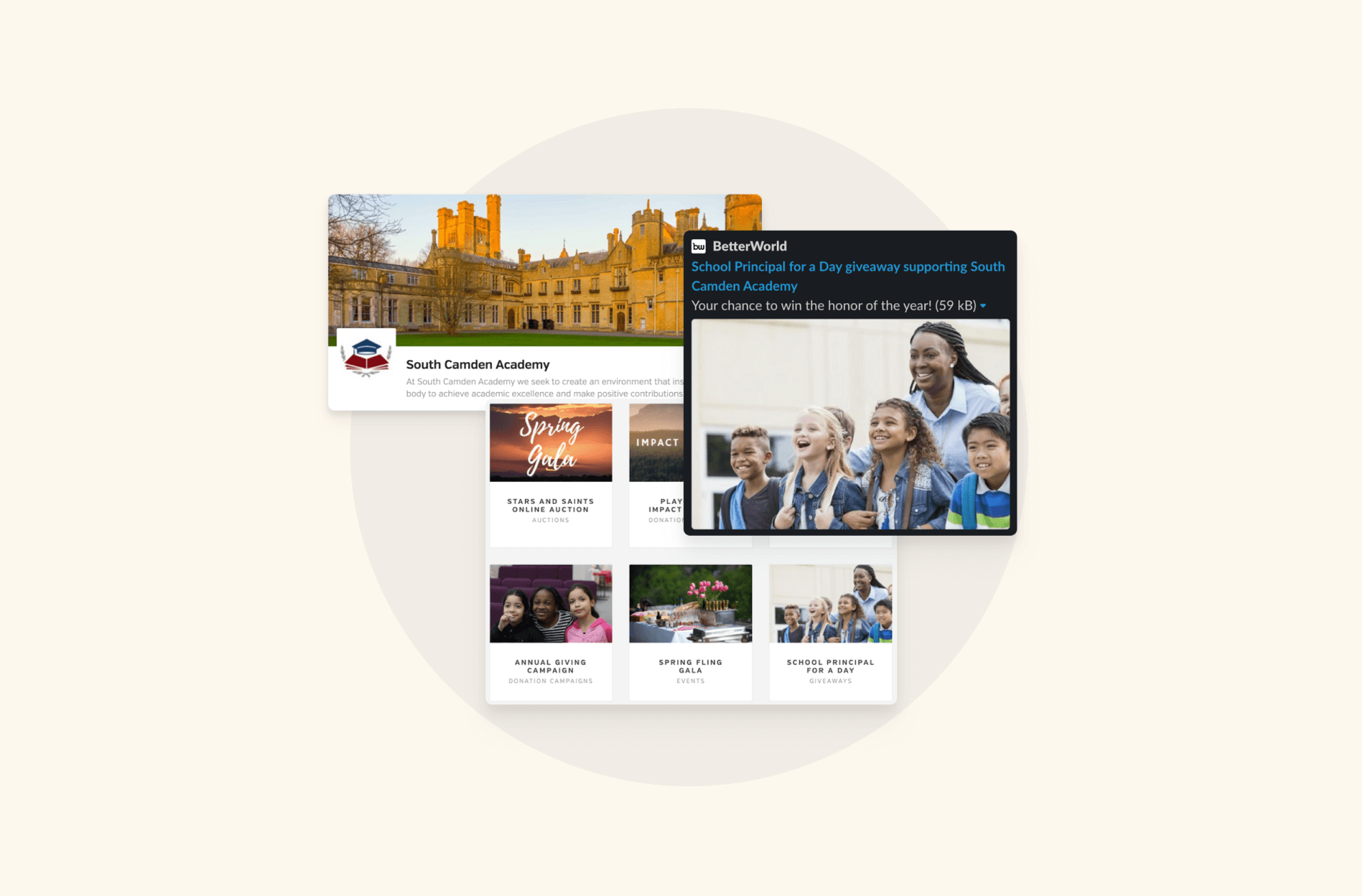Easily track and sell bundled tickets and event sponsorships
Custom Questions — ask for any information you need from ticket purchasers
Drive engagement and raise more with auto-updating leaderboards
Add YouTube or Vimeo livestream right to your event with a click
Virtual Event Planning: The Ultimate Guide for Nonprofits
By Whit Hunter

In today’s day and age, virtual events have become a popular and effective way for nonprofits to raise donations and create meaningful impact. These prove to be convenient for a world where everyone is busy hustling.
From defining the goals to selecting the right platform for your event, executing a successful virtual event needs careful and strategic planning. From the outside, this seems like a lot of work, but if done correctly, your non-profit can raise funds effortlessly.
This guide will discuss all the valuable tips and insights which you can follow to help you plan a virtual event for your non-profit and maximize your fundraising efforts.
If you want to make your virtual event a success, signup with BetterWorld. Our powerful platform makes it easy to collect donations for your virtual event. You can connect with donors from around the world and maximize your impact.
Set Your Virtual Event Goals
When planning a virtual fundraiser, the first thing to target is your fundraising goals. Try to set goals by keeping both financial and non-financial objectives in mind. Establishing these clear guidelines in the first stage would help you stay focused from the beginning till the end.
It's important to have a clear idea about what you want to achieve before you start planning the entire event. A great way is to make a checklist and set specific targets that can help you stay focused on the main goal.
A well-defined goal can help you choose the type of virtual event you want to host and identify your target audience.
To set clear goals all you need to do is ask yourself these questions:
- What are you raising money for?
- Where will the funds go?
- What is your target for the fundraiser?
Establishing clear goals from the get-go will help you create a strategic plan for the virtual event and help execute it properly.
Identify Your Virtual Event Target Audience
After establishing your goals; the most important step is to identify the target audience. Create a list of your target attendees with the understanding that the audiences can differ from that of an in-person event.
This is because a virtual event is accessible from anywhere, so go all out and invite people who live overseas or in a different city. A global audience would likely bring in more funds. However, be careful not to invite just anyone and everyone.
A great and effective way to identify your target audience is to determine the kind of people who would be interested in the cause of your fundraiser. Apart from attendees, you can even invite public keynote speakers to attend the virtual event.
This would add a nice kick to the event and keep the attendees engaged. You could also Invite public figures who would love to promote the cause and invite sponsors to help you execute the event with their funds.
Select the Event Type
Virtual events are of various types; they can be live streams, webinars, as well as pre-recorded sessions. You can plan different types of virtual fundraisers such as online auctions, peer-to-peer fundraising, virtual runs/walks, or live-streamed events.
Each type depends on several factors and delivers unique benefits. When selecting the virtual event type for your fundraiser, it’s crucial to choose the one that aligns with the organization's mission and fundraising goals.
You should also keep in mind the preferences of your target audience, the technical capabilities of the team, and the attendees. Here are some types of virtual events that you can host for your non-profit.
Different Types of Virtual Events
#1 Virtual Auctions
Having your own virtual fundraising event has its benefits, such as you get access to as many donors as possible. For the event, your non-profit can hold a virtual auction as they are flexible and convenient for donors.
Moreover, they require very little planning as they don’t require a physical venue. Attendees can bid on auction items from the comfort of their homes while using mobile bidding tools that are integrated into virtual auction events.
With BetterWorld, you can access a perfectly synced virtual platform for your event that donors can easily access, no matter where they are located.
#2 Virtual Galas
As a nonprofit, you can also host a virtual gala with interactive segments like concerts, virtual trivia, and public speaking sessions. These can increase donor engagement and also provide a unique and immersive experience to the attendees globally.
#3 Virtual Walks & Runs
Virtual walks and runs are online sessions where participants complete a walk or run at their own preferred time and location while raising funds for a cause.
The participants can even use fitness-tracking apps or devices to record their total steps and share their achievements online.
#4 Viewing Parties
A viewing party is an online event that allows the attendees to connect and watch a movie, documentary, or any other video, together while raising awareness and funds for a cause.
Nonprofits can easily host a viewing party and collect plenty of donations because participants can join from anywhere and engage in real-time discussions related to the content being watched. It's a great opportunity for donor engagement and raising funds.
Just find a movie or documentary related to your fundraising cause and host a viewing party to create an impact and awareness.
#5 Livestream concert
Nonprofits can also host a live stream concert and hire artists to deliver a musical performance virtually as a fundraiser. Attendees and viewers can purchase tickets to raise money for the fundraiser or make donations during the live streams.
#6 Virtual Keynote Speaking
Nonprofits can hire a virtual keynote speaker to educate and motivate the attendees. If you find the right speaker, they can inspire your audience to get involved and donate big.
Assemble a Team
Putting together the perfect team for a virtual nonprofit is important for its success. Start by determining the key roles for the event, such as event host, coordinator, tech support, marketing head, and volunteer management.
Recruit members who have the relevant skills and experience to carry out their roles and responsibilities efficiently. Make sure each member is well-trained and familiar with the online platform and the online tools used in the virtual event.
Assembling a motivated and capable team can ensure a well-executed and successful virtual event.
Plan Your Virtual Event
This is where all the work begins and is the point where you can decide to take your virtual event in a number of different directions.
Plan the event details to the letter and consider all the aspects of the event that you want to execute. Here are the important aspects you need to map out for your virtual event.
#1 Evaluate the Risk Factors
Before planning any fundraising event, make sure that the timings are correct. You don’t want to jump into the virtual fundraising event. Look at the current trends and events which can act as a hindrance to your virtual event goals, identify them, and then make your decision.
There can be a number of different circumstances that can affect your decision. Research thoroughly and then make the final decision.
#2 Set a Budget
Set a clear budget for your fundraiser because this will help you allocate your resources effectively. First, identify your expenses and see what costs are associated with executing an event. This can include technology costs, platform fees, speaker fees, and many more.
After that, determine your revenue stream and how you plan to generate funds from the event. It can include virtual tickets, sponsorships, and donations.
Now set a budget, and if you think your virtual event is going out of your planned budget, look for ways to save money, such as opting for free-of-cost technology and partnering/collaborating with sponsors.
#3 Select the Date and Time
Choosing a date and time which works best for your attendees is crucial. You should select the time and date based on several circumstances, such as different time zones and the audience's work schedules.
If you have people attending your event from overseas, you can provide them with a recorded version of the proceeding. Avoid scheduling the virtual event on a major holiday that can distract the target audience from your virtual event.
#4 Length of the Event
The length of the virtual event should be long enough to keep the audience engaged and short enough to avoid burnout. The event can range from one to three hours maximum. Plan for short breaks if the event is too prolonged.
#5 Theme and Content
Decide what type of theme and content you will be incorporating into your virtual event. Consider choosing a cause-specific theme for the virtual fundraiser.
Get your participants to share personal stories relevant to the cause and incorporate interactive activities and live performances to engage the attendees. The event content should keep everyone engaged and well-aligned with the cause to generate donations.
People’s attention spans are shorter in virtual events so it's important to keep the content as attractive and attention-grabbing as possible.
#6 Do a Test Run
Doing a test before your actual event is critical to ensure that everything goes according to plan. This will help you try out all the technical aspects (such as video, audio, and all the interactive features of the online platform) beforehand.
Make sure to run by the event agenda through your team, ask the volunteers and team members to rehearse, check all the necessary equipment, and troubleshoot potential issues. All of this will help identify any glitches beforehand.
Market your Virtual Event
After successfully planning the virtual event, it's time to get the word out and promote the event. To attract as many supporters for your virtual event, it needs to make noise online.
The potential attendees should know all the details about your event and what to expect from it. The best way to do that is to promote and raise awareness on various online platforms.
Here are a few online platforms that can help you generate awareness and drive more audience to the virtual event.
Social Media
Social media is one of the greatest free tools to create big hype around your virtual fundraiser. Facebook, Instagram, Twitter, and TikTok are just one of the many social media platforms you can utilize to create a buzz around the cause.
You can post engaging videos, stories, and interactive polls to generate interest and awareness about the cause.
Make a Website
Create a website with a dedicated landing page specifically for the virtual event.
You can use the website in many forms to promote your virtual event, including a simple call to action section, using compelling event descriptions, posting blogs/newsletters, and placing a registration form for the event.
BetterWorld offers a real-time, perfectly synced virtual event platform!
Online Ads
Online ads are a powerful tool to promote your virtual event because they can reach a wide audience. These can help you effectively target your desired audience and generate organic engagement to your virtual event.
Find Key Participants for Your Virtual Event Type
A fundraiser is nothing without its participants and sponsors. Make the most of your nonprofit’s network of partners and sponsors by contacting them ahead of the event day.
Partners and sponsors can help spread the word, donate auction items, as well as provide financial support for the whole event. Identifying potential partners who also share your fundraising values enough to sponsor the event is important.
To attract key participants, explain how they can benefit from working alongside your nonprofit. Try your best to acknowledge and thank them by featuring their names and logos on your website and social media platforms.
You can also offer their products or services in the auction items.
Choose a Virtual Event Platform
The online platform you choose for your nonprofit’s virtual fundraising event is very important. Search for a platform that is accessible to everyone and can also handle live streaming. A platform that has strong security features and provides user-friendly applications will be ideal.
BetterWorld uses cutting-edge technology to make online fundraising easy and secure for nonprofits. Our fundraising platform is designed to be incredibly easy to use. Set up an account and start raising funds in minutes.
Execute Your Virtual Event
After all the careful planning and coordination, all you need to do is execute the event and engage with the attendees. Create a small checklist to ensure that every detail is followed to the T.
Here is a small checklist and timeline to help you plan a successful virtual event.
3 Months Before the Event
- Identify goals and objectives for the fundraiser
- Choose the event platform or software
- Create an event budget
- Allocate resources
- Create an event agenda
- Plan the marketing strategies and promote the event
- Get guest speakers and presenters on board
- Test the technical equipment
1 to 2 Weeks Before the Event
- Conduct rehearsals with the volunteers and presenters
- Finalize the event schedule
- Send out event reminders to registered attendees
- Prepare content material, slides, and resources
- Conduct a test run and trouble any issue
Event Day
- Launch the event platform and ensure all features are working properly
- Monitor the event in real-time
- Address attendee inquiries
- Engage with attendees
- Execute event presentation
- Capture the event data for evaluation
Post-Event Follow-Up
If you want to create long-term relationships with the sponsors and participants, it’s important to follow up with them after your virtual event ends.
Reach out to the donors and express your gratitude for their support and ask them for their feedback on the event to make them feel more involved. Following up is important since most attendees don't donate during the event itself but after the event.
Also, provide them with the donation receipts and updates on how the funds are being used. Many donors like it when they see where their donations are being used and how good of an impact their donations have left.
Conclusion
Make sure to follow these guidelines to plan your virtual event. These steps will increase the likelihood of success that can engage your attendees, raise funds as well as support your nonprofit’s fundraising goals.
Join BetterWorld to increase the likelihood of success of your virtual fundraising efforts.

Join 105,000+ amazing nonprofits, organizations, and fundraisers on BetterWorld

Let our FREE fundraising tools help you raise more funds with less effort








